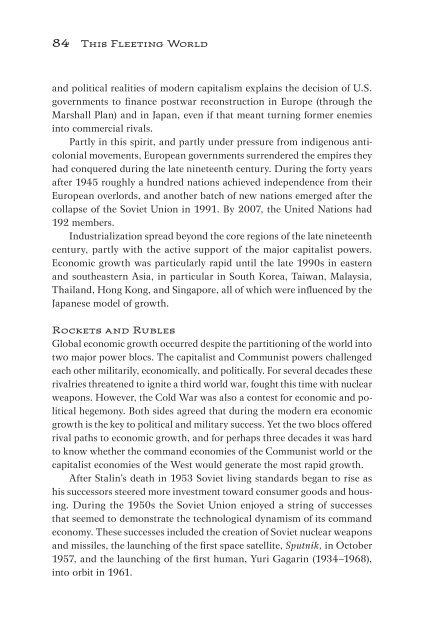This Fleeting World
This Fleeting World
This Fleeting World
Create successful ePaper yourself
Turn your PDF publications into a flip-book with our unique Google optimized e-Paper software.
84 <strong>This</strong> <strong>Fleeting</strong> <strong>World</strong><br />
and political realities of modern capitalism explains the decision of U.S.<br />
governments to finance postwar reconstruction in Europe (through the<br />
Marshall Plan) and in Japan, even if that meant turning former enemies<br />
into commercial rivals.<br />
Partly in this spirit, and partly under pressure from indigenous anticolonial<br />
movements, European governments surrendered the empires they<br />
had conquered during the late nineteenth century. During the forty years<br />
after 1945 roughly a hundred nations achieved independence from their<br />
European overlords, and another batch of new nations emerged after the<br />
collapse of the Soviet Union in 1991. By 2007, the United Nations had<br />
192 members.<br />
Industrialization spread beyond the core regions of the late nineteenth<br />
century, partly with the active support of the major capitalist powers.<br />
Economic growth was particularly rapid until the late 1990s in eastern<br />
and southeastern Asia, in particular in South Korea, Taiwan, Malaysia,<br />
Thailand, Hong Kong, and Singapore, all of which were influenced by the<br />
Japanese model of growth.<br />
Rockets and Rubles<br />
Global economic growth occurred despite the partitioning of the world into<br />
two major power blocs. The capitalist and Communist powers challenged<br />
each other militarily, economically, and politically. For several decades these<br />
rivalries threatened to ignite a third world war, fought this time with nuclear<br />
weapons. However, the Cold War was also a contest for economic and political<br />
hegemony. Both sides agreed that during the modern era economic<br />
growth is the key to political and military success. Yet the two blocs offered<br />
rival paths to economic growth, and for perhaps three decades it was hard<br />
to know whether the command economies of the Communist world or the<br />
capitalist economies of the West would generate the most rapid growth.<br />
After Stalin’s death in 1953 Soviet living standards began to rise as<br />
his successors steered more investment toward consumer goods and housing.<br />
During the 1950s the Soviet Union enjoyed a string of successes<br />
that seemed to demonstrate the technological dynamism of its command<br />
economy. These successes included the creation of Soviet nuclear weapons<br />
and missiles, the launching of the first space satellite, Sputnik, in October<br />
1957, and the launching of the first human, Yuri Gagarin (1934–1968),<br />
into orbit in 1961.


